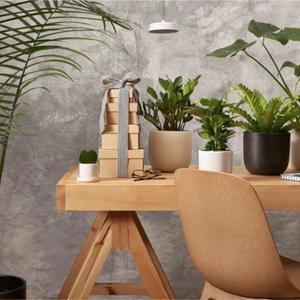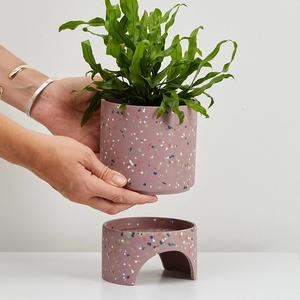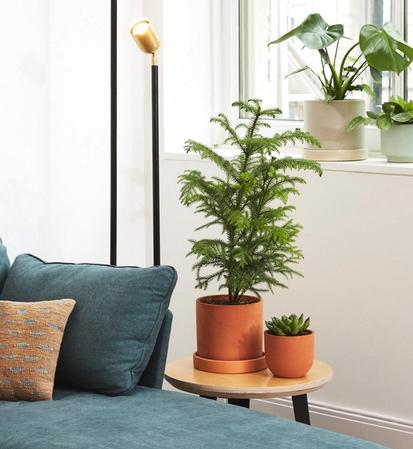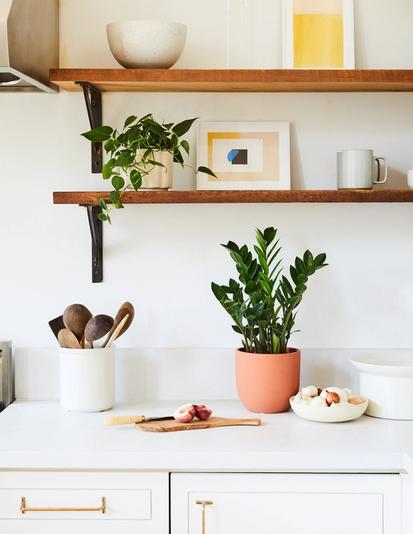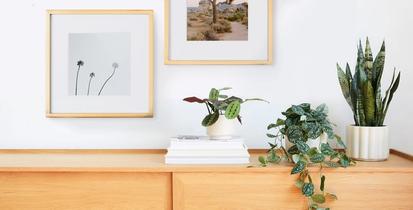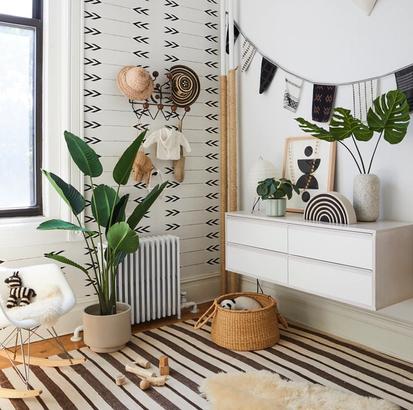The Pothos, or Epipremnum aureum, has the reputation of being one of the easiest houseplants to take care of. Its common name comes from the genus it was once classified under—Pothos aureus—and, in addition to the classic jade green Pothos, there are a few different cultivars you can look out for. These include the Golden Pothos, which is known for its heart-shaped green leaves with yellow variegation; the lime-green Pothos Neon; the velvety Satin Pothos; and the Pothos Marble Queen, featuring deeper green and white variegation.
The Pothos is particularly fitting for indoor settings because it is able to filter gaseous toxins like formaldehyde from the air. Plus, it is a climber: In its native Southeast Asia, due to its aerial root system, it is known to overgrow forest floors and tree trunks. You can help it grow vertically in the home by using a coco coir pole and in good indoor conditions, it can trail up to 10 feet tall and grow leaves that are four to eight inches long.
Pothos Marble Queen
This variety is referred to as 'Marble Queen' thanks to the swirls of deep greens and white on the plant's signature heart-shaped leaves.
Pothos Care Instructions
Whether you're looking to add greenery to a dim corner or want an easy-care plant to brighten up your home, Pothos is an excellent choice. Below, we'll explore everything you need to know to keep your pothos thriving and looking its best.
Sunlight
Pothos plants thrive in bright, indirect light to morning direct sun, but they can tolerate medium to low indirect light. Preferably found in an East or West window for bright light, or a Northern window for lower light conditions. This plant is not suited for intense, afternoon direct sun, which will burn and brown its leaves.
Not sure if your plant is receiving enough light? Try measuring with a light meter to ensure your Pothos is in the correct conditions. If you don't have the means of natural lighting, you can always use a grow light!
Water
Water your Pothos every 1-2 weeks, allowing soil to dry out between waterings. Expect to water more often in brighter light and less often in lower light. If the plant’s leaves begin curling inward or the potting mix is dry, this is a sign you need to water it more often. Conversely, if the leaves begin yellowing or the potting mix is wet, you should decrease the frequency of your watering schedule.
Humidity
Normal room humidity will do, but Pothos will feel more at home under higher humidity conditions if possible, preferably between 40-60%. Consider incorporating a humidifier to boost humidity levels more consistently if the air in the home is dry.
Temperature
The Pothos will prefer temps in the 65°F-85°F range (18°C-30°C). It’s best not to let it go below 60°F (15°C) to prevent cold damage.

Potting & Soil
Repot when its roots start growing out of the drainage holes or when it becomes root-bound, typically every 1-2 years depending on how fast it grows. Spring is the best time to repot, as the plant is actively growing. Choose a pot that’s 1-2 inches larger in diameter than the current one.
Use a well-draining potting mix that is rich in organic matter. If desired, you can mix in extra ingredients such as perlite or lava rocks to increase soil aeration and drainage around the roots.
Fertilizer
Fertilize on a bi-weekly or monthly basis during the growing season (spring and summer) using a balanced, water-soluble fertilizer applied at the time of watering. Reduce or stop fertilizing during the fall and winter when the plant’s growth slows, but if you're growing under a grow light year-round you can continue to fertilize. Always follow the instructions on the fertilizer label for best results.
Pruning
Pothos can benefit from pruning to remove dead, lackluster foliage or to create a bushier plant by pinching off the growth tips of vines.
To prune, use clean, sharp pruners to cut back any dead, damaged, or overgrown leaves and stems. If you're pruning to encourage branching it's best to do so during the growing season (spring or summer) when the plant is actively growing and cut just above a node.
Propagation
To propagate a Pothos, take a cutting that is about 2-3 inches long and cut just below a node (where a leaf is attached to the stem), ensuring the cutting has at least one leaf attached. Place the cutting in water or moist soil, keeping it in a warm, bright area but out of direct sunlight. Change the water weekly if propagating in water, or keep the soil consistently moist if using soil. Once roots are well-established, usually in a few weeks to a couple of months, transplant the cutting into a pot with well-draining soil and continue with proper care.

Common Problems
The Pothos is an easy-going plant and is generally pest-free but can be prone to mealybugs. Treat pests as soon as they appear with weekly sprays of a natural pesticide like neem oil or an insecticide and regularly wipe-down the plants leaves.
Here are some common problems you may encounter when caring for a Pothos:
SYMPTOM: Wilting plant or curling leaves, dry potting mix:
CAUSE: Thirsty plant, underwatered
SYMPTOM: Yellowing leaves, black stems:
CAUSE: Overwatered
SYMPTOM: Legginess, etiolation:
CAUSE: Not enough light

FAQs
Are Pothos toxic to cats?
Pothos can be irritating to cats, dogs, and humans if foliage is consumed. We advise keeping houseplants out of reach of small children and pets.
How big does a Pothos get?
In the wild, Pothos plants can grow up to 60 feet (18 meters) while climbing up trees; in non-tropical outdoor climates, they can grow up to 20 feet (6 meters); and indoors, they generally vine six to 10 feet (1.8 to 3 meters). Their leaves, which can grow 3 feet (one meter) long or more in the wild, indoors will typically grow four to eight inches (10-20 centimeters).
My Pothos is bare at the base, how do I fix it?
To rejuvenate a pothos that is bare at the soil, try the layering method! Gently lay one of the longer, healthy vines onto the soil surface, securing it with floral pins or paper clips so the nodes (where leaves and aerial roots form) make contact with the soil. In a few weeks, the nodes will develop roots, creating new growth at the base. If you don't have a long vine to layer, with you can always propagate stem cuttings from your plant to root and plant at the soil surface!
Words By The Sill
Empowering all people to be plant people—a collection of articles from The Sill’s team of plant experts across a variety of plant care topics to inspire confidence in the next generation of plant parents. Welcome to Plant Parenthood™.










